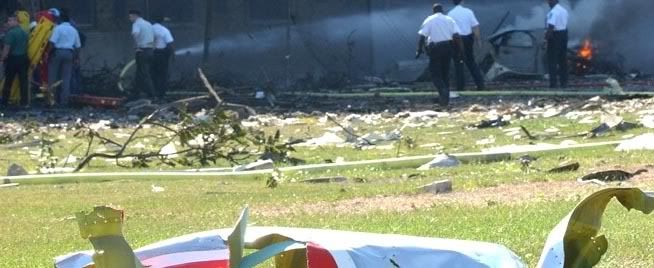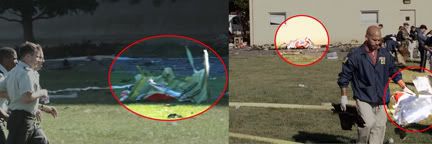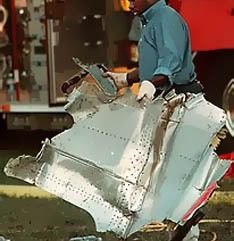Eyewitnesses to the Pentagon attack’s aftermath have repeatedly cited nothing left of the plane but scraps small enough that you could pick up in your hands, as we’d expect. Loose change-types simply adore repeating CNN reporter Jamie McIntyre’s initial reporting of this observation, much to his dismay, seeing in it an honest no-plane testimony before he was “gotten to.” The HTB skeptics love the hand-size bits because they can then turn this around and contend that the scraps are just as easy to plant by hand.
"Spooked" at Humint Events Online, likely a parody site but possibly sincere, suggested in October 2006 a "Flight 77" decoy flyover coupled with a small "beam weapon” to "knock down the lamp poles and fry the generator and create the hole in the building." the plane parts we've seen "were pre-planted and also sprinkled from an over-flying plane a la Operation Northwoods.” He explained this “it's rather tempting to wonder if this C-130,” which is verified as flying over the Pentagon just after the attack and then scoping out Shanksville, “was packed with 757 fuselage pieces (in American and United colors) to sprinkle from above.” [1] Of course it was planted if it doesn’t fit your theory. Never suspect your own theory was planted, always keep the attention elsewhere…
 Other no-757 skeptics do raise some relevant questions about the characteristics of the scraps found on the lawn, especially the piece seen above, which is here located to the north (left) of impact, famously captured by Mark Faram. This scrap is clearly from the main chassis, given the red paint generally taken as part of the ‘n’ in “American,” which is painted near the front of the fuselage. Some note the pristine quality of the metal as a clue it was planted. I wouldn’t call this pristine by a long shot, but it does look a bit nice and neat. If they’re right, these scraps may have been planted, but with this inexplicable special effects snafu built in.
Other no-757 skeptics do raise some relevant questions about the characteristics of the scraps found on the lawn, especially the piece seen above, which is here located to the north (left) of impact, famously captured by Mark Faram. This scrap is clearly from the main chassis, given the red paint generally taken as part of the ‘n’ in “American,” which is painted near the front of the fuselage. Some note the pristine quality of the metal as a clue it was planted. I wouldn’t call this pristine by a long shot, but it does look a bit nice and neat. If they’re right, these scraps may have been planted, but with this inexplicable special effects snafu built in. The other thing some have noted is that if the main chassis entered the building intact as alleged, and was only blown up, torn up, and burned up as it pierced 300 feet deep, it would be highly odd that such scraps would be outside. It must be noted the tail section also has a giant red "A" on the tailfin, which more than the chassis should be expected outside, but other photos likethe "c" shown below are clearly from the front lettering.
As for the unpainted wings widely cited as "disappearing" upon impact since they weren't found sheared off whole: They would have exploded, as the place the fuel was stored, and been left outside in small peces. The tailfin is more likely to have survived intact, but has not been seen, and may heve blow up into pieces as well in te general explosion. I would look in the field of shiny metal scraps for the possible remains of these silver appendages:


Here are two more shots from the same general area showing three more fuselage sections with parts of an AA paint job. The building in the background on the right is the heliport, where pieces are apparently being gathered and then taken elsewhere by FBI agents for some kind of investigative work.
As to precisely where they were first picked up it’s hard to say. That they would be being fished out of the flaming wreckage inside the building before singeing is clearly not the case – they were obviously outside the building. Were they scraped off by the second floor slab as the cockpit and upper fuselage entered? If so I’d expect deeper crumpling than that.
 |
So we’ve seen what may well be parts from a Rolls Royce RB 211 engine or engines, landing gear matching a B757’s in size, scale, and design, metal scraps marked like wing, chassis, and/or tail sections from an AA commercial jetliner and we’re down to the scraps. But the HTB people may still be holding out for yet further proof. Indeed, much remains to be seen: The nosecone, cockpit control panels, seats, passengers (or have we seen these?), oxygen masks, box cutters, plane tickets, official American Airlines napkins, etc. And of course all of those can be planted too.









No comments:
Post a Comment